IoT Security and Privacy: Challenges and Future Implications
VerifiedAdded on 2021/06/15
|9
|2288
|224
Report
AI Summary
This report provides a comprehensive overview of the Internet of Things (IoT), focusing on its security and privacy challenges. It begins with an introduction to IoT, defining its core concepts and evolution, and then delves into the growth and diverse applications of IoT across various sectors. The report identifies key challenges, including the high cost of implementation and privacy concerns related to data security and user tracking. It explores relevant theoretical foundations, such as the Theory of Diffusion of Innovation and the Theory of the Social Shaping of Technology, to explain the spread and impact of IoT. The executive summary outlines the research purpose, scope, and methodology, including the use of research design and questionnaires, highlighting the widespread access to the internet and the adoption of smartphones and laptops as primary devices. The report concludes with recommendations for enhancing IoT adoption and security, emphasizing the importance of internet access in remote areas and the benefits of IoT in improving communication, data transfer, and security. The report also provides references to relevant literature, offering a detailed analysis of the current state and future implications of IoT.
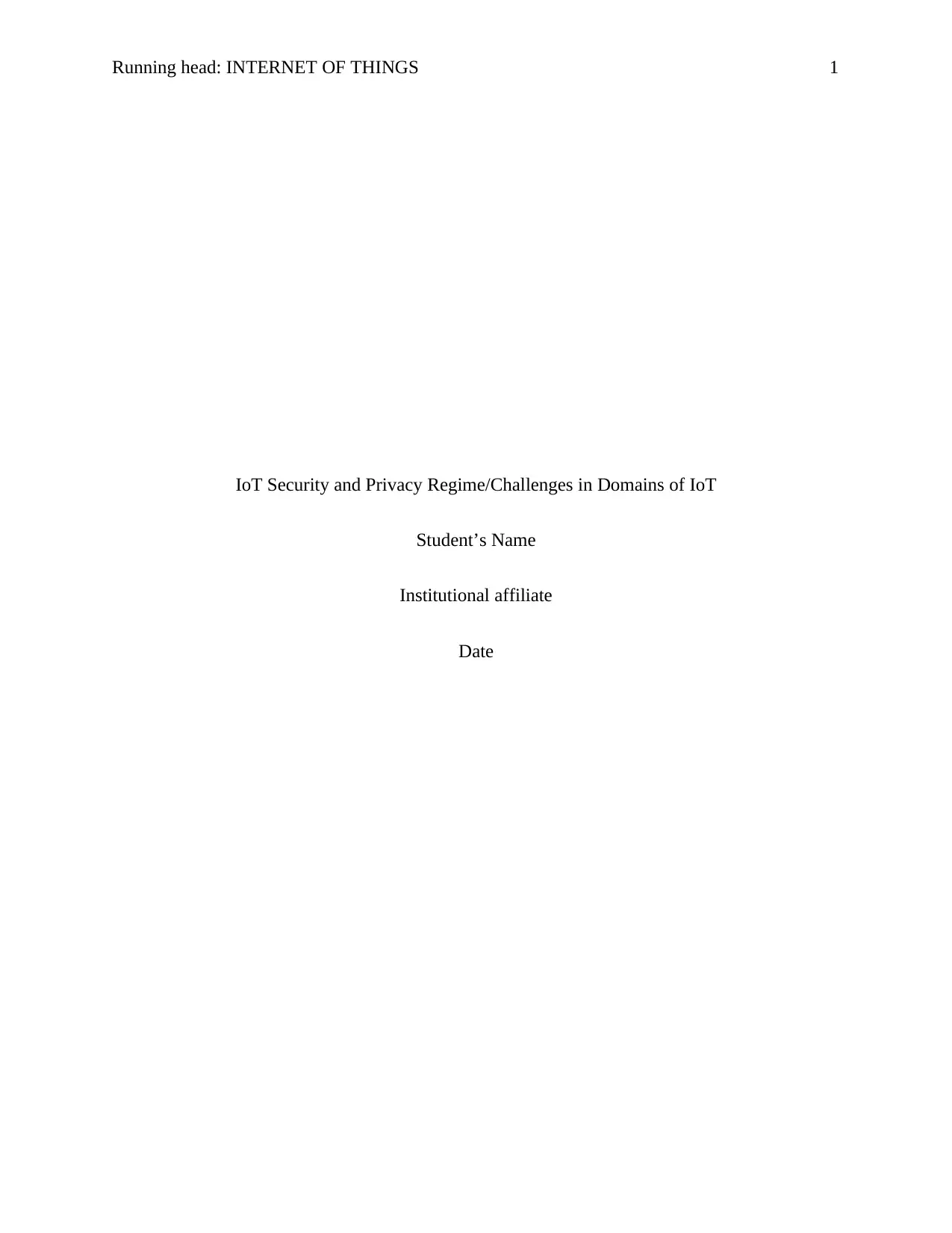
Running head: INTERNET OF THINGS 1
IoT Security and Privacy Regime/Challenges in Domains of IoT
Student’s Name
Institutional affiliate
Date
IoT Security and Privacy Regime/Challenges in Domains of IoT
Student’s Name
Institutional affiliate
Date
Paraphrase This Document
Need a fresh take? Get an instant paraphrase of this document with our AI Paraphraser
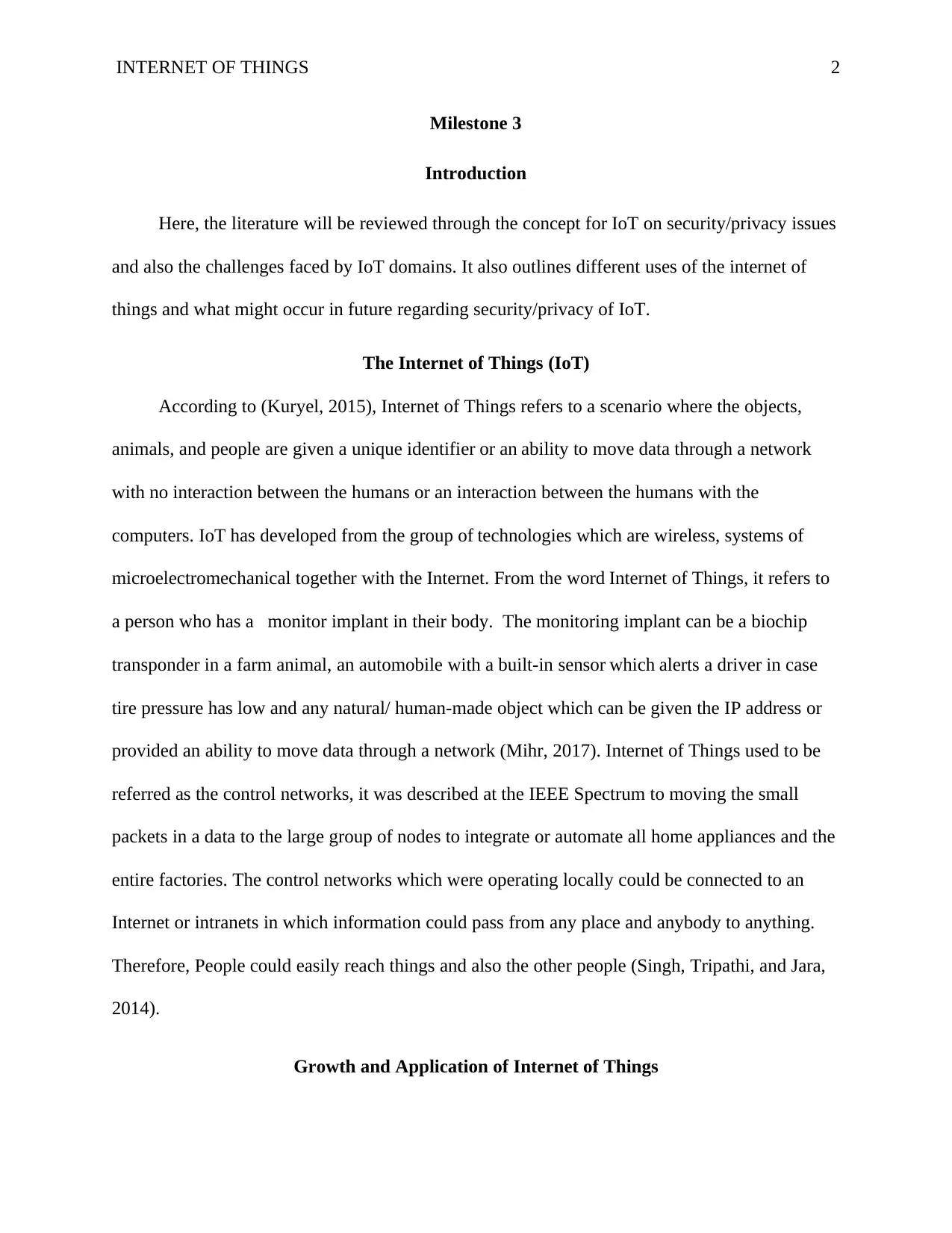
INTERNET OF THINGS 2
Milestone 3
Introduction
Here, the literature will be reviewed through the concept for IoT on security/privacy issues
and also the challenges faced by IoT domains. It also outlines different uses of the internet of
things and what might occur in future regarding security/privacy of IoT.
The Internet of Things (IoT)
According to (Kuryel, 2015), Internet of Things refers to a scenario where the objects,
animals, and people are given a unique identifier or an ability to move data through a network
with no interaction between the humans or an interaction between the humans with the
computers. IoT has developed from the group of technologies which are wireless, systems of
microelectromechanical together with the Internet. From the word Internet of Things, it refers to
a person who has a monitor implant in their body. The monitoring implant can be a biochip
transponder in a farm animal, an automobile with a built-in sensor which alerts a driver in case
tire pressure has low and any natural/ human-made object which can be given the IP address or
provided an ability to move data through a network (Mihr, 2017). Internet of Things used to be
referred as the control networks, it was described at the IEEE Spectrum to moving the small
packets in a data to the large group of nodes to integrate or automate all home appliances and the
entire factories. The control networks which were operating locally could be connected to an
Internet or intranets in which information could pass from any place and anybody to anything.
Therefore, People could easily reach things and also the other people (Singh, Tripathi, and Jara,
2014).
Growth and Application of Internet of Things
Milestone 3
Introduction
Here, the literature will be reviewed through the concept for IoT on security/privacy issues
and also the challenges faced by IoT domains. It also outlines different uses of the internet of
things and what might occur in future regarding security/privacy of IoT.
The Internet of Things (IoT)
According to (Kuryel, 2015), Internet of Things refers to a scenario where the objects,
animals, and people are given a unique identifier or an ability to move data through a network
with no interaction between the humans or an interaction between the humans with the
computers. IoT has developed from the group of technologies which are wireless, systems of
microelectromechanical together with the Internet. From the word Internet of Things, it refers to
a person who has a monitor implant in their body. The monitoring implant can be a biochip
transponder in a farm animal, an automobile with a built-in sensor which alerts a driver in case
tire pressure has low and any natural/ human-made object which can be given the IP address or
provided an ability to move data through a network (Mihr, 2017). Internet of Things used to be
referred as the control networks, it was described at the IEEE Spectrum to moving the small
packets in a data to the large group of nodes to integrate or automate all home appliances and the
entire factories. The control networks which were operating locally could be connected to an
Internet or intranets in which information could pass from any place and anybody to anything.
Therefore, People could easily reach things and also the other people (Singh, Tripathi, and Jara,
2014).
Growth and Application of Internet of Things
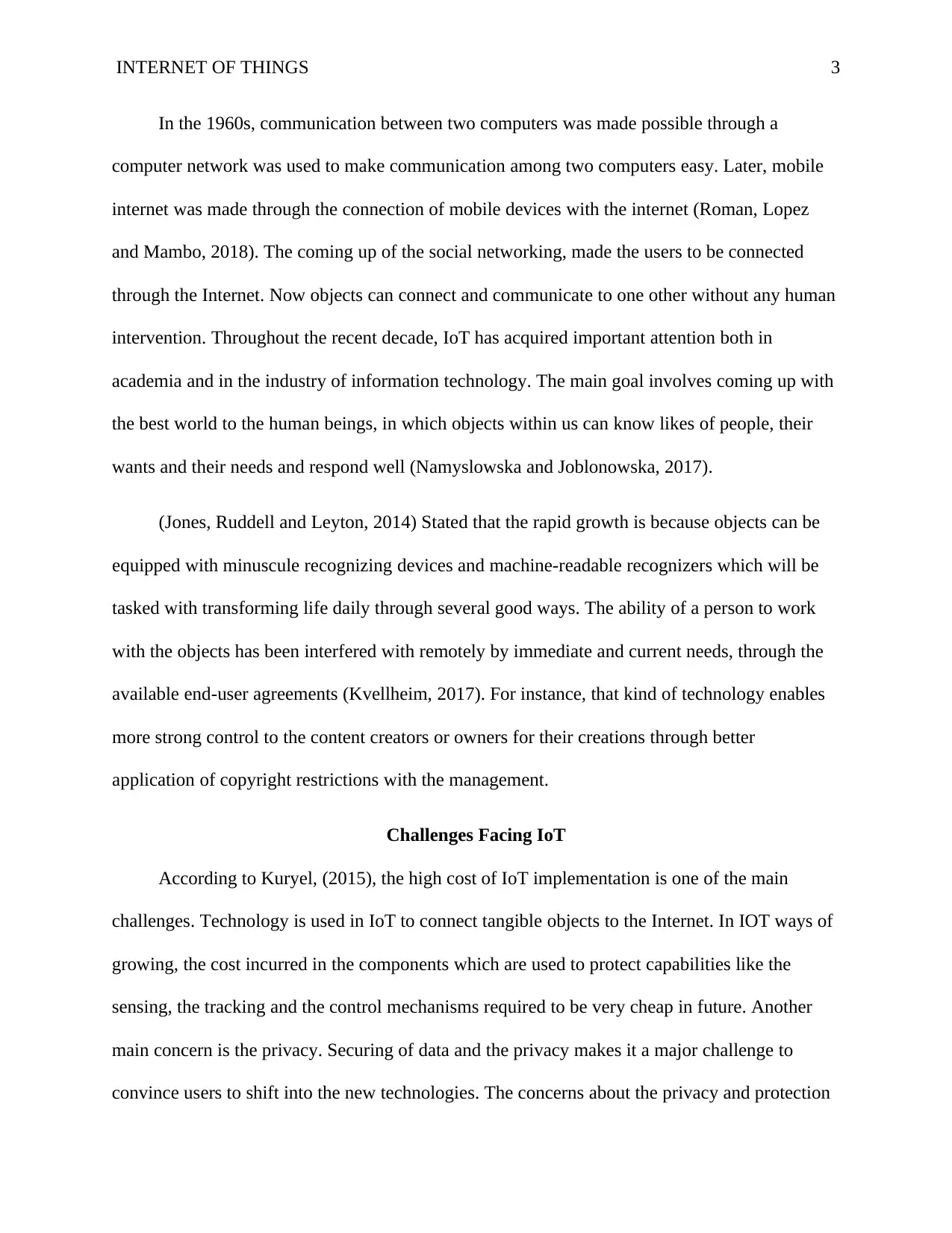
INTERNET OF THINGS 3
In the 1960s, communication between two computers was made possible through a
computer network was used to make communication among two computers easy. Later, mobile
internet was made through the connection of mobile devices with the internet (Roman, Lopez
and Mambo, 2018). The coming up of the social networking, made the users to be connected
through the Internet. Now objects can connect and communicate to one other without any human
intervention. Throughout the recent decade, IoT has acquired important attention both in
academia and in the industry of information technology. The main goal involves coming up with
the best world to the human beings, in which objects within us can know likes of people, their
wants and their needs and respond well (Namyslowska and Joblonowska, 2017).
(Jones, Ruddell and Leyton, 2014) Stated that the rapid growth is because objects can be
equipped with minuscule recognizing devices and machine-readable recognizers which will be
tasked with transforming life daily through several good ways. The ability of a person to work
with the objects has been interfered with remotely by immediate and current needs, through the
available end-user agreements (Kvellheim, 2017). For instance, that kind of technology enables
more strong control to the content creators or owners for their creations through better
application of copyright restrictions with the management.
Challenges Facing IoT
According to Kuryel, (2015), the high cost of IoT implementation is one of the main
challenges. Technology is used in IoT to connect tangible objects to the Internet. In IOT ways of
growing, the cost incurred in the components which are used to protect capabilities like the
sensing, the tracking and the control mechanisms required to be very cheap in future. Another
main concern is the privacy. Securing of data and the privacy makes it a major challenge to
convince users to shift into the new technologies. The concerns about the privacy and protection
In the 1960s, communication between two computers was made possible through a
computer network was used to make communication among two computers easy. Later, mobile
internet was made through the connection of mobile devices with the internet (Roman, Lopez
and Mambo, 2018). The coming up of the social networking, made the users to be connected
through the Internet. Now objects can connect and communicate to one other without any human
intervention. Throughout the recent decade, IoT has acquired important attention both in
academia and in the industry of information technology. The main goal involves coming up with
the best world to the human beings, in which objects within us can know likes of people, their
wants and their needs and respond well (Namyslowska and Joblonowska, 2017).
(Jones, Ruddell and Leyton, 2014) Stated that the rapid growth is because objects can be
equipped with minuscule recognizing devices and machine-readable recognizers which will be
tasked with transforming life daily through several good ways. The ability of a person to work
with the objects has been interfered with remotely by immediate and current needs, through the
available end-user agreements (Kvellheim, 2017). For instance, that kind of technology enables
more strong control to the content creators or owners for their creations through better
application of copyright restrictions with the management.
Challenges Facing IoT
According to Kuryel, (2015), the high cost of IoT implementation is one of the main
challenges. Technology is used in IoT to connect tangible objects to the Internet. In IOT ways of
growing, the cost incurred in the components which are used to protect capabilities like the
sensing, the tracking and the control mechanisms required to be very cheap in future. Another
main concern is the privacy. Securing of data and the privacy makes it a major challenge to
convince users to shift into the new technologies. The concerns about the privacy and protection
⊘ This is a preview!⊘
Do you want full access?
Subscribe today to unlock all pages.

Trusted by 1+ million students worldwide
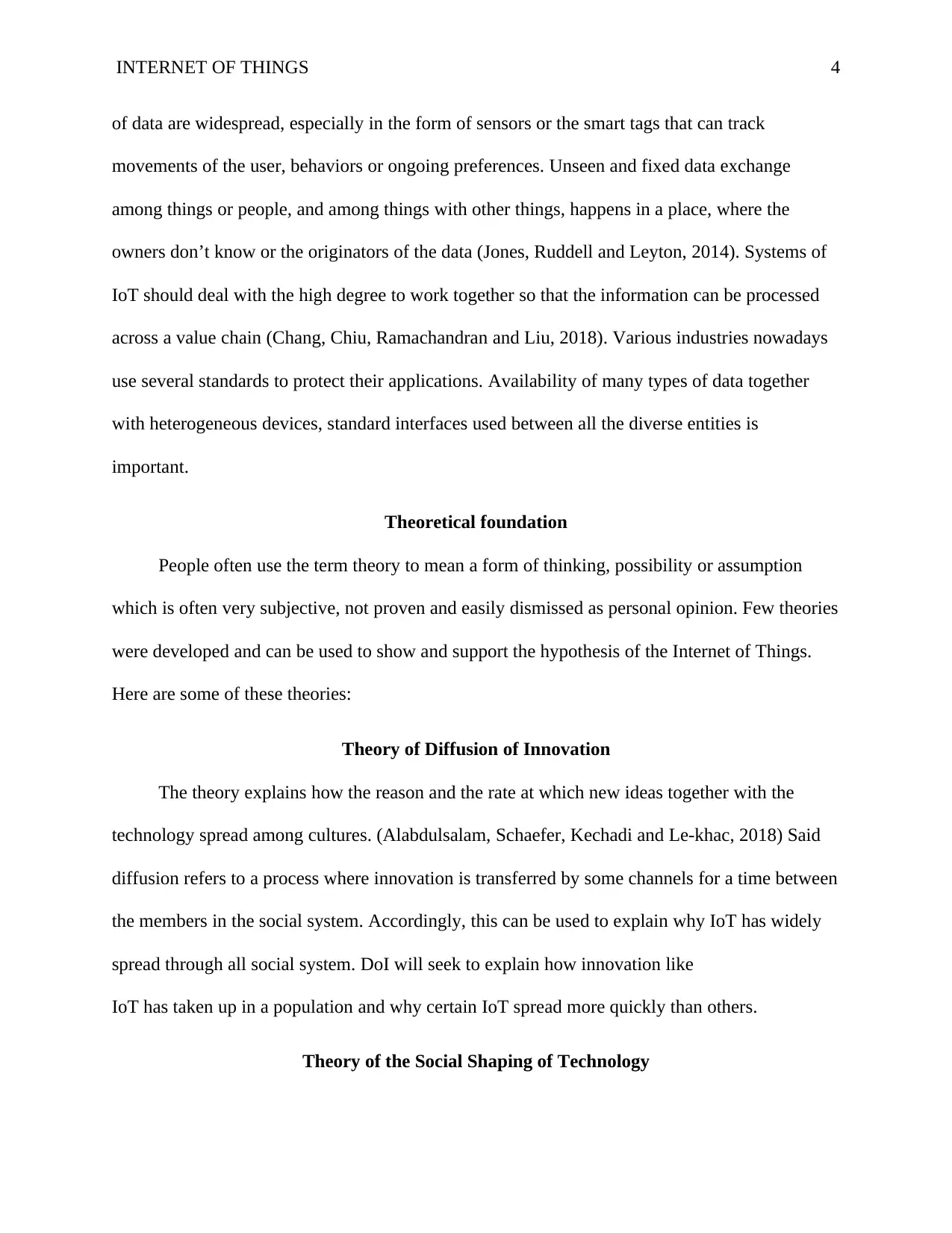
INTERNET OF THINGS 4
of data are widespread, especially in the form of sensors or the smart tags that can track
movements of the user, behaviors or ongoing preferences. Unseen and fixed data exchange
among things or people, and among things with other things, happens in a place, where the
owners don’t know or the originators of the data (Jones, Ruddell and Leyton, 2014). Systems of
IoT should deal with the high degree to work together so that the information can be processed
across a value chain (Chang, Chiu, Ramachandran and Liu, 2018). Various industries nowadays
use several standards to protect their applications. Availability of many types of data together
with heterogeneous devices, standard interfaces used between all the diverse entities is
important.
Theoretical foundation
People often use the term theory to mean a form of thinking, possibility or assumption
which is often very subjective, not proven and easily dismissed as personal opinion. Few theories
were developed and can be used to show and support the hypothesis of the Internet of Things.
Here are some of these theories:
Theory of Diffusion of Innovation
The theory explains how the reason and the rate at which new ideas together with the
technology spread among cultures. (Alabdulsalam, Schaefer, Kechadi and Le-khac, 2018) Said
diffusion refers to a process where innovation is transferred by some channels for a time between
the members in the social system. Accordingly, this can be used to explain why IoT has widely
spread through all social system. DoI will seek to explain how innovation like
IoT has taken up in a population and why certain IoT spread more quickly than others.
Theory of the Social Shaping of Technology
of data are widespread, especially in the form of sensors or the smart tags that can track
movements of the user, behaviors or ongoing preferences. Unseen and fixed data exchange
among things or people, and among things with other things, happens in a place, where the
owners don’t know or the originators of the data (Jones, Ruddell and Leyton, 2014). Systems of
IoT should deal with the high degree to work together so that the information can be processed
across a value chain (Chang, Chiu, Ramachandran and Liu, 2018). Various industries nowadays
use several standards to protect their applications. Availability of many types of data together
with heterogeneous devices, standard interfaces used between all the diverse entities is
important.
Theoretical foundation
People often use the term theory to mean a form of thinking, possibility or assumption
which is often very subjective, not proven and easily dismissed as personal opinion. Few theories
were developed and can be used to show and support the hypothesis of the Internet of Things.
Here are some of these theories:
Theory of Diffusion of Innovation
The theory explains how the reason and the rate at which new ideas together with the
technology spread among cultures. (Alabdulsalam, Schaefer, Kechadi and Le-khac, 2018) Said
diffusion refers to a process where innovation is transferred by some channels for a time between
the members in the social system. Accordingly, this can be used to explain why IoT has widely
spread through all social system. DoI will seek to explain how innovation like
IoT has taken up in a population and why certain IoT spread more quickly than others.
Theory of the Social Shaping of Technology
Paraphrase This Document
Need a fresh take? Get an instant paraphrase of this document with our AI Paraphraser
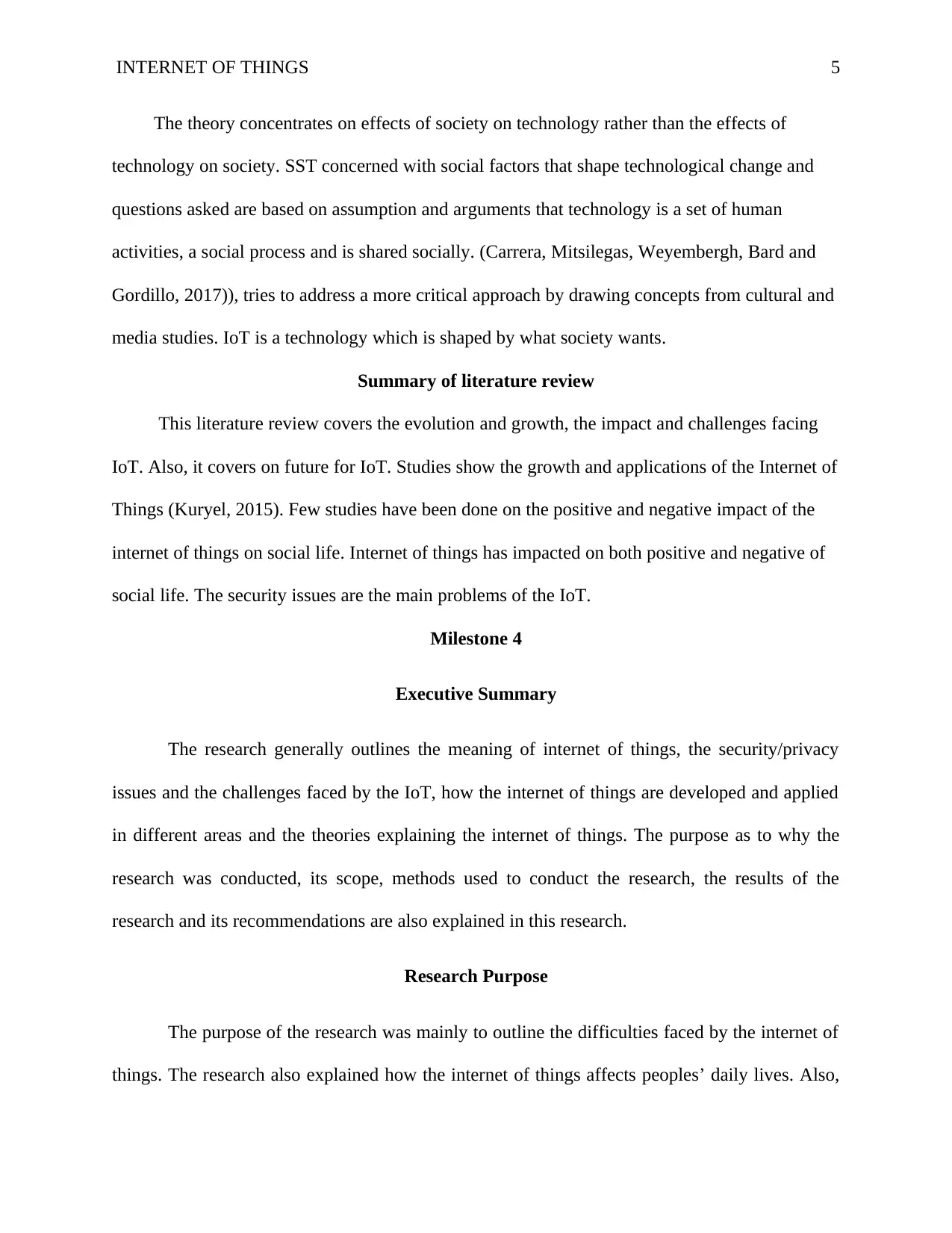
INTERNET OF THINGS 5
The theory concentrates on effects of society on technology rather than the effects of
technology on society. SST concerned with social factors that shape technological change and
questions asked are based on assumption and arguments that technology is a set of human
activities, a social process and is shared socially. (Carrera, Mitsilegas, Weyembergh, Bard and
Gordillo, 2017)), tries to address a more critical approach by drawing concepts from cultural and
media studies. IoT is a technology which is shaped by what society wants.
Summary of literature review
This literature review covers the evolution and growth, the impact and challenges facing
IoT. Also, it covers on future for IoT. Studies show the growth and applications of the Internet of
Things (Kuryel, 2015). Few studies have been done on the positive and negative impact of the
internet of things on social life. Internet of things has impacted on both positive and negative of
social life. The security issues are the main problems of the IoT.
Milestone 4
Executive Summary
The research generally outlines the meaning of internet of things, the security/privacy
issues and the challenges faced by the IoT, how the internet of things are developed and applied
in different areas and the theories explaining the internet of things. The purpose as to why the
research was conducted, its scope, methods used to conduct the research, the results of the
research and its recommendations are also explained in this research.
Research Purpose
The purpose of the research was mainly to outline the difficulties faced by the internet of
things. The research also explained how the internet of things affects peoples’ daily lives. Also,
The theory concentrates on effects of society on technology rather than the effects of
technology on society. SST concerned with social factors that shape technological change and
questions asked are based on assumption and arguments that technology is a set of human
activities, a social process and is shared socially. (Carrera, Mitsilegas, Weyembergh, Bard and
Gordillo, 2017)), tries to address a more critical approach by drawing concepts from cultural and
media studies. IoT is a technology which is shaped by what society wants.
Summary of literature review
This literature review covers the evolution and growth, the impact and challenges facing
IoT. Also, it covers on future for IoT. Studies show the growth and applications of the Internet of
Things (Kuryel, 2015). Few studies have been done on the positive and negative impact of the
internet of things on social life. Internet of things has impacted on both positive and negative of
social life. The security issues are the main problems of the IoT.
Milestone 4
Executive Summary
The research generally outlines the meaning of internet of things, the security/privacy
issues and the challenges faced by the IoT, how the internet of things are developed and applied
in different areas and the theories explaining the internet of things. The purpose as to why the
research was conducted, its scope, methods used to conduct the research, the results of the
research and its recommendations are also explained in this research.
Research Purpose
The purpose of the research was mainly to outline the difficulties faced by the internet of
things. The research also explained how the internet of things affects peoples’ daily lives. Also,
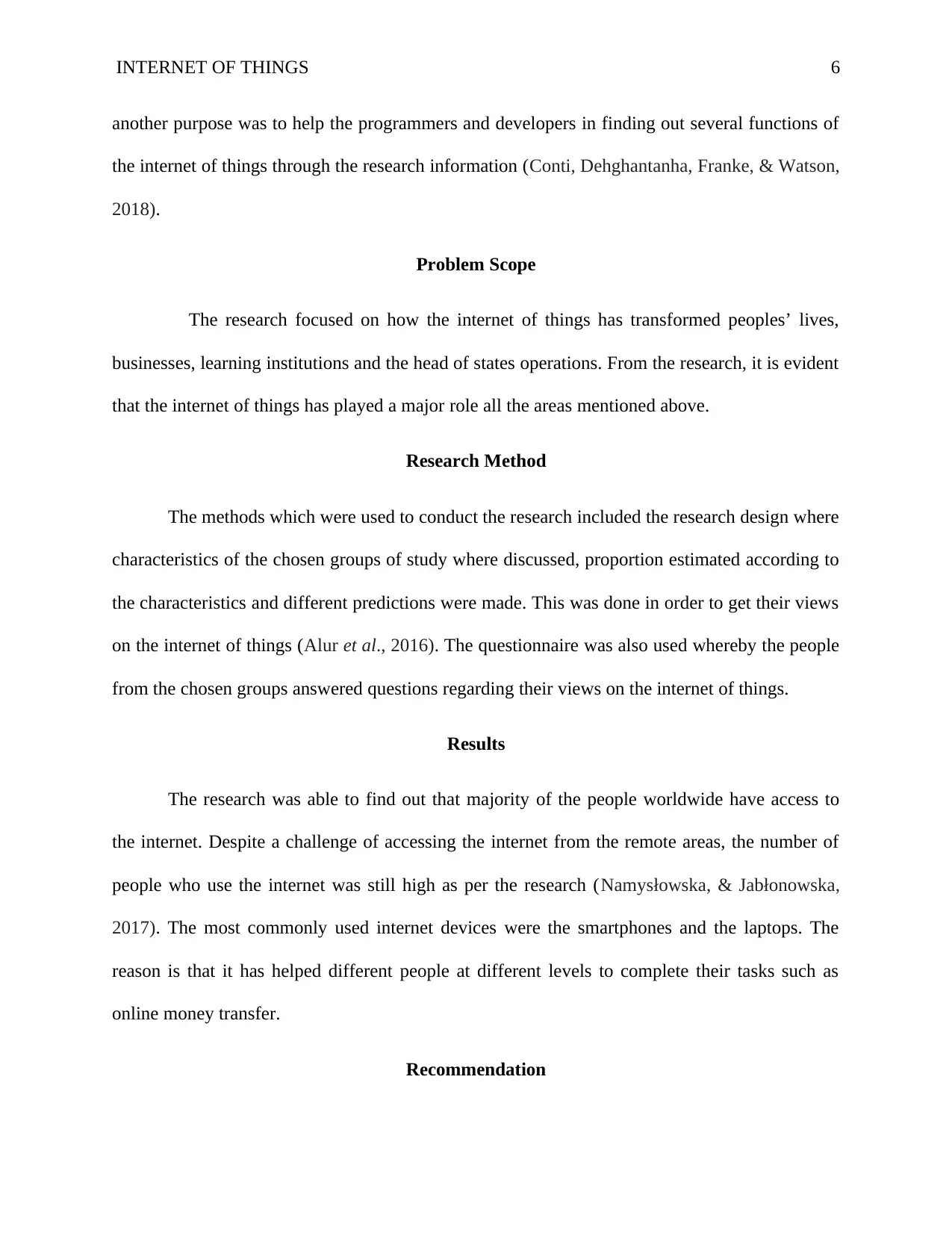
INTERNET OF THINGS 6
another purpose was to help the programmers and developers in finding out several functions of
the internet of things through the research information (Conti, Dehghantanha, Franke, & Watson,
2018).
Problem Scope
The research focused on how the internet of things has transformed peoples’ lives,
businesses, learning institutions and the head of states operations. From the research, it is evident
that the internet of things has played a major role all the areas mentioned above.
Research Method
The methods which were used to conduct the research included the research design where
characteristics of the chosen groups of study where discussed, proportion estimated according to
the characteristics and different predictions were made. This was done in order to get their views
on the internet of things (Alur et al., 2016). The questionnaire was also used whereby the people
from the chosen groups answered questions regarding their views on the internet of things.
Results
The research was able to find out that majority of the people worldwide have access to
the internet. Despite a challenge of accessing the internet from the remote areas, the number of
people who use the internet was still high as per the research (Namysłowska, & Jabłonowska,
2017). The most commonly used internet devices were the smartphones and the laptops. The
reason is that it has helped different people at different levels to complete their tasks such as
online money transfer.
Recommendation
another purpose was to help the programmers and developers in finding out several functions of
the internet of things through the research information (Conti, Dehghantanha, Franke, & Watson,
2018).
Problem Scope
The research focused on how the internet of things has transformed peoples’ lives,
businesses, learning institutions and the head of states operations. From the research, it is evident
that the internet of things has played a major role all the areas mentioned above.
Research Method
The methods which were used to conduct the research included the research design where
characteristics of the chosen groups of study where discussed, proportion estimated according to
the characteristics and different predictions were made. This was done in order to get their views
on the internet of things (Alur et al., 2016). The questionnaire was also used whereby the people
from the chosen groups answered questions regarding their views on the internet of things.
Results
The research was able to find out that majority of the people worldwide have access to
the internet. Despite a challenge of accessing the internet from the remote areas, the number of
people who use the internet was still high as per the research (Namysłowska, & Jabłonowska,
2017). The most commonly used internet devices were the smartphones and the laptops. The
reason is that it has helped different people at different levels to complete their tasks such as
online money transfer.
Recommendation
⊘ This is a preview!⊘
Do you want full access?
Subscribe today to unlock all pages.

Trusted by 1+ million students worldwide
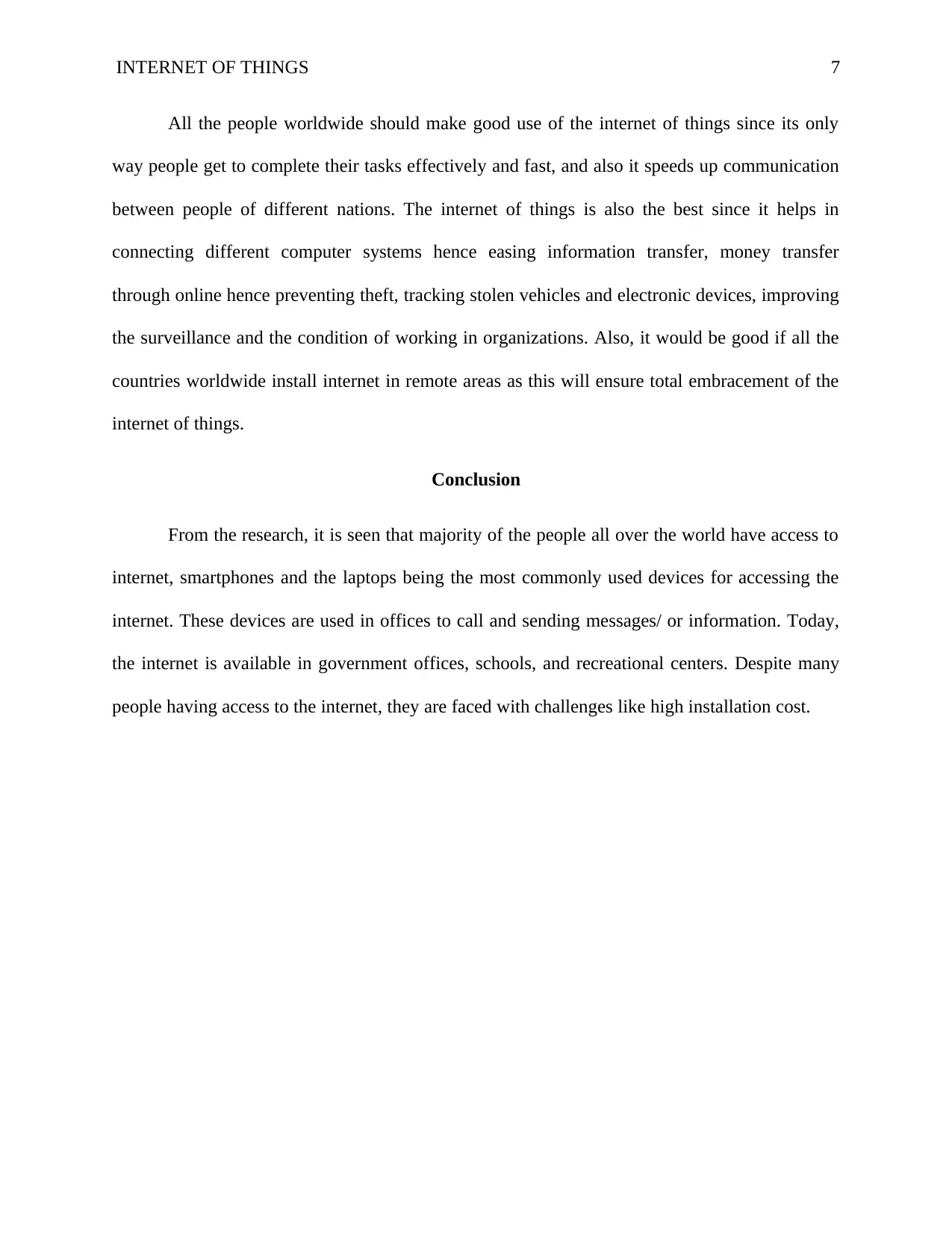
INTERNET OF THINGS 7
All the people worldwide should make good use of the internet of things since its only
way people get to complete their tasks effectively and fast, and also it speeds up communication
between people of different nations. The internet of things is also the best since it helps in
connecting different computer systems hence easing information transfer, money transfer
through online hence preventing theft, tracking stolen vehicles and electronic devices, improving
the surveillance and the condition of working in organizations. Also, it would be good if all the
countries worldwide install internet in remote areas as this will ensure total embracement of the
internet of things.
Conclusion
From the research, it is seen that majority of the people all over the world have access to
internet, smartphones and the laptops being the most commonly used devices for accessing the
internet. These devices are used in offices to call and sending messages/ or information. Today,
the internet is available in government offices, schools, and recreational centers. Despite many
people having access to the internet, they are faced with challenges like high installation cost.
All the people worldwide should make good use of the internet of things since its only
way people get to complete their tasks effectively and fast, and also it speeds up communication
between people of different nations. The internet of things is also the best since it helps in
connecting different computer systems hence easing information transfer, money transfer
through online hence preventing theft, tracking stolen vehicles and electronic devices, improving
the surveillance and the condition of working in organizations. Also, it would be good if all the
countries worldwide install internet in remote areas as this will ensure total embracement of the
internet of things.
Conclusion
From the research, it is seen that majority of the people all over the world have access to
internet, smartphones and the laptops being the most commonly used devices for accessing the
internet. These devices are used in offices to call and sending messages/ or information. Today,
the internet is available in government offices, schools, and recreational centers. Despite many
people having access to the internet, they are faced with challenges like high installation cost.
Paraphrase This Document
Need a fresh take? Get an instant paraphrase of this document with our AI Paraphraser
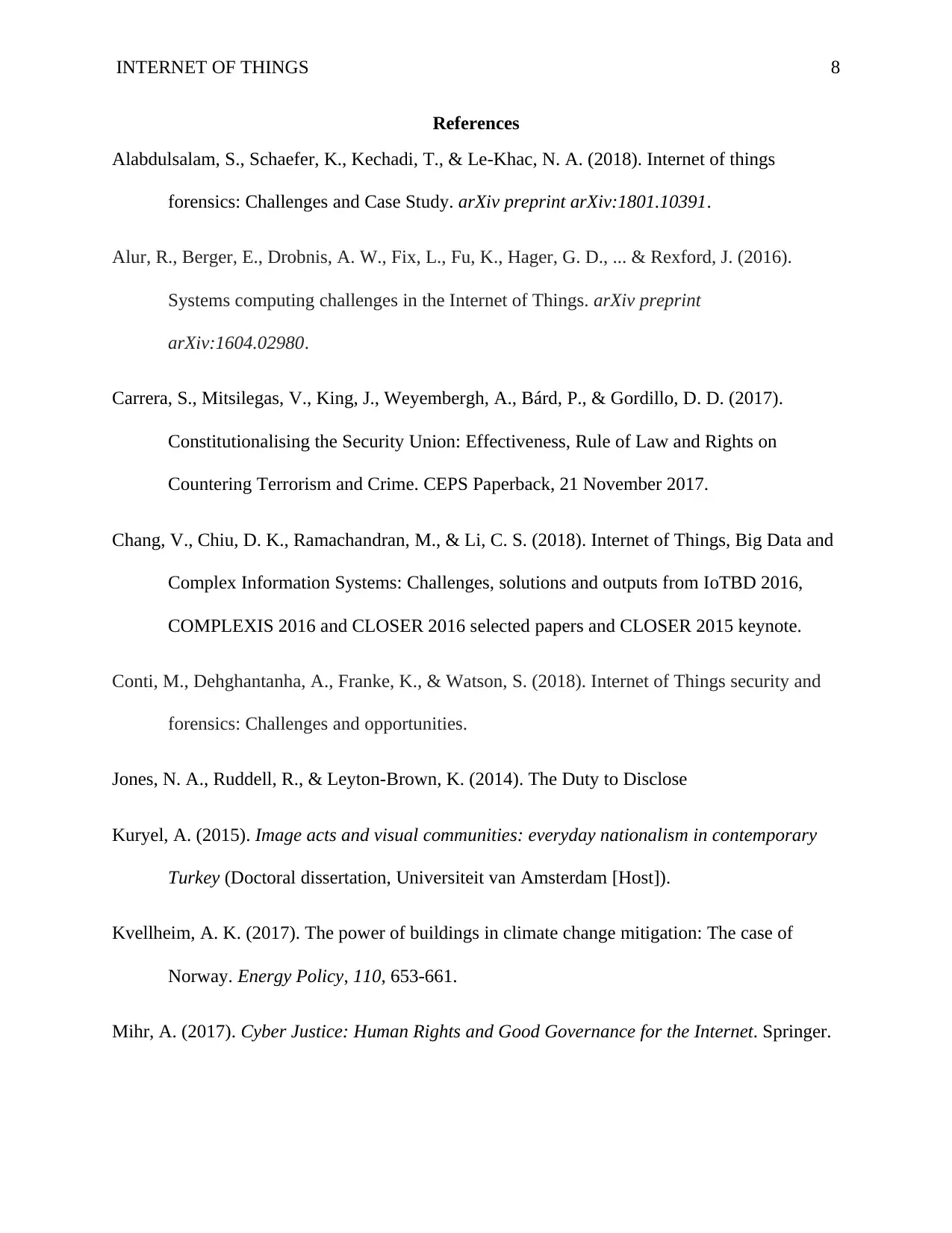
INTERNET OF THINGS 8
References
Alabdulsalam, S., Schaefer, K., Kechadi, T., & Le-Khac, N. A. (2018). Internet of things
forensics: Challenges and Case Study. arXiv preprint arXiv:1801.10391.
Alur, R., Berger, E., Drobnis, A. W., Fix, L., Fu, K., Hager, G. D., ... & Rexford, J. (2016).
Systems computing challenges in the Internet of Things. arXiv preprint
arXiv:1604.02980.
Carrera, S., Mitsilegas, V., King, J., Weyembergh, A., Bárd, P., & Gordillo, D. D. (2017).
Constitutionalising the Security Union: Effectiveness, Rule of Law and Rights on
Countering Terrorism and Crime. CEPS Paperback, 21 November 2017.
Chang, V., Chiu, D. K., Ramachandran, M., & Li, C. S. (2018). Internet of Things, Big Data and
Complex Information Systems: Challenges, solutions and outputs from IoTBD 2016,
COMPLEXIS 2016 and CLOSER 2016 selected papers and CLOSER 2015 keynote.
Conti, M., Dehghantanha, A., Franke, K., & Watson, S. (2018). Internet of Things security and
forensics: Challenges and opportunities.
Jones, N. A., Ruddell, R., & Leyton-Brown, K. (2014). The Duty to Disclose
Kuryel, A. (2015). Image acts and visual communities: everyday nationalism in contemporary
Turkey (Doctoral dissertation, Universiteit van Amsterdam [Host]).
Kvellheim, A. K. (2017). The power of buildings in climate change mitigation: The case of
Norway. Energy Policy, 110, 653-661.
Mihr, A. (2017). Cyber Justice: Human Rights and Good Governance for the Internet. Springer.
References
Alabdulsalam, S., Schaefer, K., Kechadi, T., & Le-Khac, N. A. (2018). Internet of things
forensics: Challenges and Case Study. arXiv preprint arXiv:1801.10391.
Alur, R., Berger, E., Drobnis, A. W., Fix, L., Fu, K., Hager, G. D., ... & Rexford, J. (2016).
Systems computing challenges in the Internet of Things. arXiv preprint
arXiv:1604.02980.
Carrera, S., Mitsilegas, V., King, J., Weyembergh, A., Bárd, P., & Gordillo, D. D. (2017).
Constitutionalising the Security Union: Effectiveness, Rule of Law and Rights on
Countering Terrorism and Crime. CEPS Paperback, 21 November 2017.
Chang, V., Chiu, D. K., Ramachandran, M., & Li, C. S. (2018). Internet of Things, Big Data and
Complex Information Systems: Challenges, solutions and outputs from IoTBD 2016,
COMPLEXIS 2016 and CLOSER 2016 selected papers and CLOSER 2015 keynote.
Conti, M., Dehghantanha, A., Franke, K., & Watson, S. (2018). Internet of Things security and
forensics: Challenges and opportunities.
Jones, N. A., Ruddell, R., & Leyton-Brown, K. (2014). The Duty to Disclose
Kuryel, A. (2015). Image acts and visual communities: everyday nationalism in contemporary
Turkey (Doctoral dissertation, Universiteit van Amsterdam [Host]).
Kvellheim, A. K. (2017). The power of buildings in climate change mitigation: The case of
Norway. Energy Policy, 110, 653-661.
Mihr, A. (2017). Cyber Justice: Human Rights and Good Governance for the Internet. Springer.
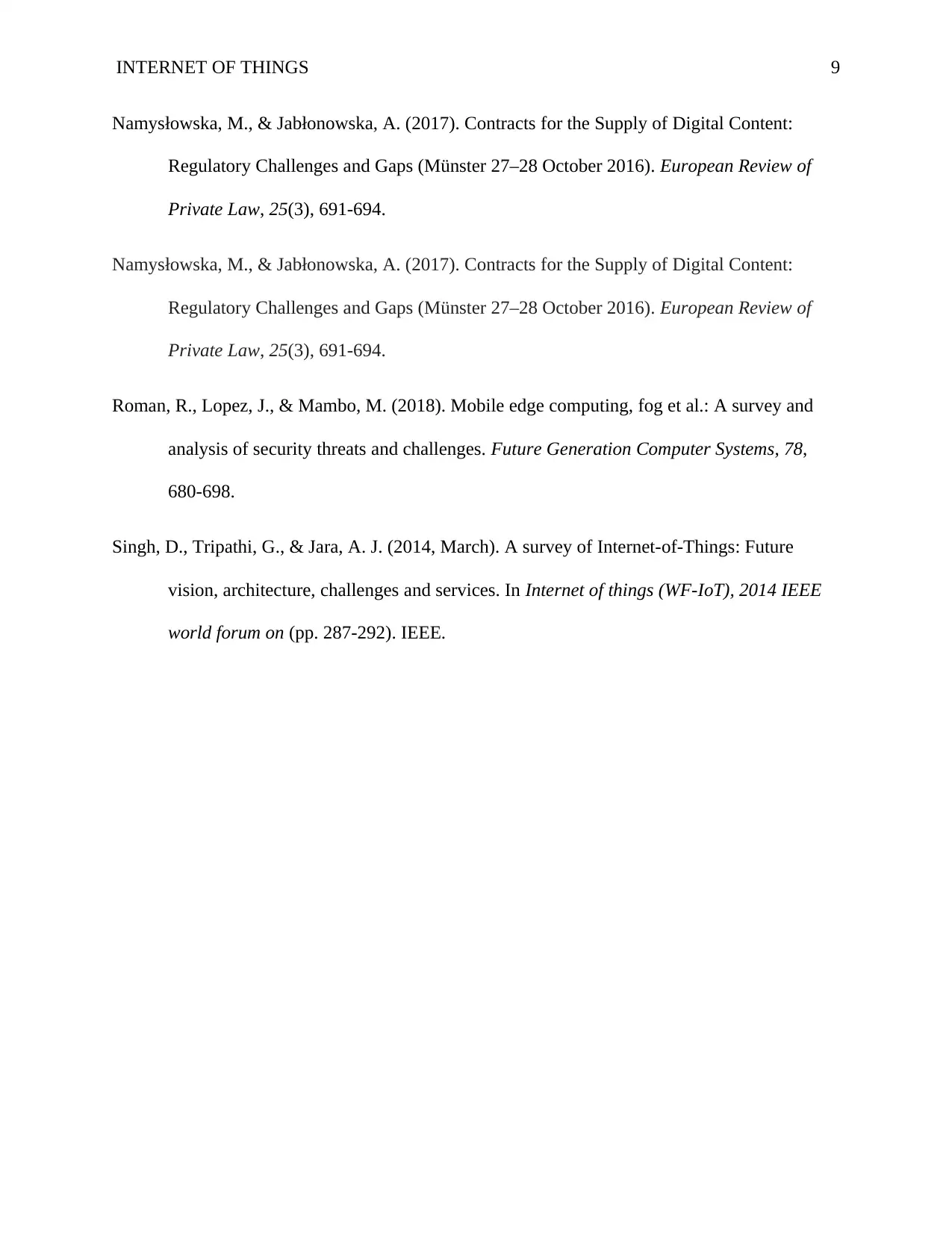
INTERNET OF THINGS 9
Namysłowska, M., & Jabłonowska, A. (2017). Contracts for the Supply of Digital Content:
Regulatory Challenges and Gaps (Münster 27–28 October 2016). European Review of
Private Law, 25(3), 691-694.
Namysłowska, M., & Jabłonowska, A. (2017). Contracts for the Supply of Digital Content:
Regulatory Challenges and Gaps (Münster 27–28 October 2016). European Review of
Private Law, 25(3), 691-694.
Roman, R., Lopez, J., & Mambo, M. (2018). Mobile edge computing, fog et al.: A survey and
analysis of security threats and challenges. Future Generation Computer Systems, 78,
680-698.
Singh, D., Tripathi, G., & Jara, A. J. (2014, March). A survey of Internet-of-Things: Future
vision, architecture, challenges and services. In Internet of things (WF-IoT), 2014 IEEE
world forum on (pp. 287-292). IEEE.
Namysłowska, M., & Jabłonowska, A. (2017). Contracts for the Supply of Digital Content:
Regulatory Challenges and Gaps (Münster 27–28 October 2016). European Review of
Private Law, 25(3), 691-694.
Namysłowska, M., & Jabłonowska, A. (2017). Contracts for the Supply of Digital Content:
Regulatory Challenges and Gaps (Münster 27–28 October 2016). European Review of
Private Law, 25(3), 691-694.
Roman, R., Lopez, J., & Mambo, M. (2018). Mobile edge computing, fog et al.: A survey and
analysis of security threats and challenges. Future Generation Computer Systems, 78,
680-698.
Singh, D., Tripathi, G., & Jara, A. J. (2014, March). A survey of Internet-of-Things: Future
vision, architecture, challenges and services. In Internet of things (WF-IoT), 2014 IEEE
world forum on (pp. 287-292). IEEE.
⊘ This is a preview!⊘
Do you want full access?
Subscribe today to unlock all pages.

Trusted by 1+ million students worldwide
1 out of 9
Related Documents
Your All-in-One AI-Powered Toolkit for Academic Success.
+13062052269
info@desklib.com
Available 24*7 on WhatsApp / Email
![[object Object]](/_next/static/media/star-bottom.7253800d.svg)
Unlock your academic potential
Copyright © 2020–2025 A2Z Services. All Rights Reserved. Developed and managed by ZUCOL.




